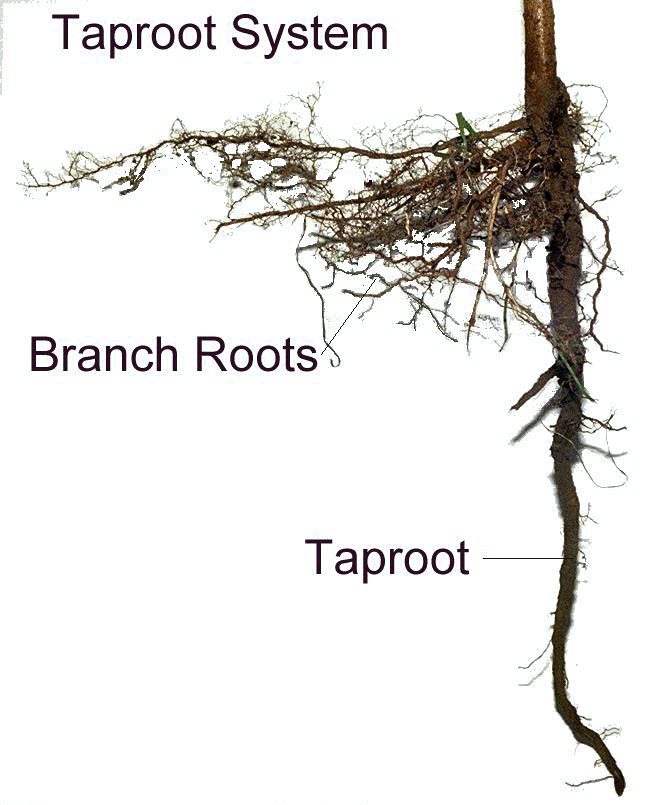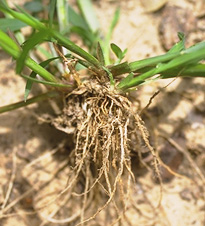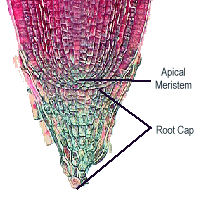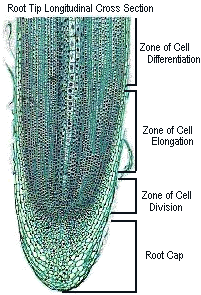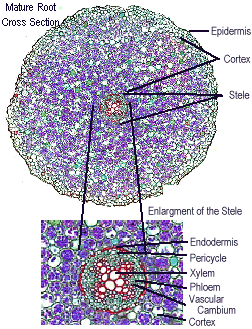Root Systems:
Taproot System:
Characterized by having one main root (the taproot) from which smaller branch roots emerge. When a seed germinates, the first root to emerge is the radicle, or primary root. In conifers and most dicots, this radicle develops into the taproot. Taproots can be modified for use in storage (usually carbohydrates) such as those found in sugar beet or carrot. Taproots are also important adaptations for searching for water, as those long taproots found in mesquite and poison ivy.
Top of PageFibrous Root System:
Characterized by having a mass of similarly sized roots. In this case the radicle from a germinating seed is short lived and is replaced by adventitious roots. Adventitious roots are roots that form on plant organs other than roots. Most monocots have fibrous root systems. Some fibrous roots are used as storage; for example sweet potatoes form on fibrous roots. Plants with fibrous roots systems are excellent for erosion control, because the mass of roots cling to soil particles.
Top of Page
Root Structures and Their Functions:
Root Tip: the end 1 cm of a root contains young tissues that are divided into the root cap, quiescent center, and the subapical region.
Root Cap: root tips are covered and protected by the root cap. The root cap cells are derived from the rootcap meristem that pushes cells forward into the cap region. Root cap cells differentiate first into columella cells. Columella cells contain amylopasts that are responsible for gravity detection. These cells can also respond to light and pressure from soil particles. Once columella cells are pushed to the periphery of the root cap, they differentiate into peripheral cells. These cells secrete mucigel, a hydrated polysaccharide formed in the dictyosomes that contains sugars, organic acids, vitamins, enzymes, and amino acids. Mucigel aids in protection of the root by preventing desiccation. In some plants the mucigel contains inhibitors that prevent the growth of roots from competing plants. Mucigel also lubricates the root so that it can easily penetrate the soil. Mucigel also aids in water and nutrient absorption by increasing soil:root contact. Mucigel can act as a chelator, freeing up ions to be absorbed by the root. Nutrients in mucigel can aid in the establishment of mycorrhizae and symbiotic bacteria.
Quiescent Center: behind the root cap is the quiescent center, a region of inactive cells. They function to replace the meristematic cells of the rootcap meristem. The quiescent center is also important in organizing the patterns of primary growth in the root.
Subapical Region: this region, behind the quiescent center is divided into three zones. Zone of Cell Division - this is the location of the apical meristem (~0.5 -1.5 mm behind the root tip). Cells derived from the apical meristem add to the primary growth of the root. Zone of Cellular Elongation - the cells derived from the apical meristem increase in length in this region. Elongation occurs through water uptake into the vacuoles. This elongation process shoves the root tip into the soil. Zone of Cellular Maturation - the cells begin differentiation. In this region one finds root hairs which function to increase water and nutrient absorption. In this region the xylem cells are the first of the vascular tissues to differentiate.
Top of PageMature Root: the primary tissues of the root begin to form within or just behind the Zone of Cellular Maturation in the root tip. The root apical meristem gives rise to three primary meristems: protoderm, ground meristem, and procambium.
Epidermis: the epidermis is derived from the protoderm and surrounds the young root one cell layer thick. Epidermal cells are not covered by cuticle so that they can absorb water and mineral nutrients. As roots mature the epidermis is replaced by the periderm.
Cortex: interior to the epidermis is the cortex which is derived from the ground meristem. The cortex is divided into three layers: the hypodermis, storage parenchyma cells, and the endodermis. The hypodermis is the suberinized protective layer of cells just below the epidermis. The suberin in these cells aids in water retention. Storage parenchyma cells are thin-walled and often store starch. The endodermis is the innermost layer of the cortex. Endodermal cells are closely packed and lack intercellular spaces. Their radial and transverse walls are impregnated with lignin an suberin to form the structure called the Casparian Strip. The Casparian Strip forces water and dissolved nutrients to pass through the symplast (living portion of the cell), thus allowing the cell membrane to control absorption by the root.
Stele: all tissues inside the endodermis compose the stele. The stele includes the outer most layer, pericycle, and the vascular tissues. The pericycle is a meristematic layer important in production of branch roots. The vascular tissues are made up of the xylem and phloem. In dicots the xylem is found as a star shape in the center of the root with the phloem located between the arms of the xylem star. New xylem and phloem is added by the vascular cambium located between the xylem and phloem. In monocots the xylem and phloem form in a ring with s the central portion of the root made up of a parenchymatous pith.
Top of Page
Taproot System
Fibrous Root System
Root Structures & Their Functions
Root Tip: young root tissues
Mature Root
